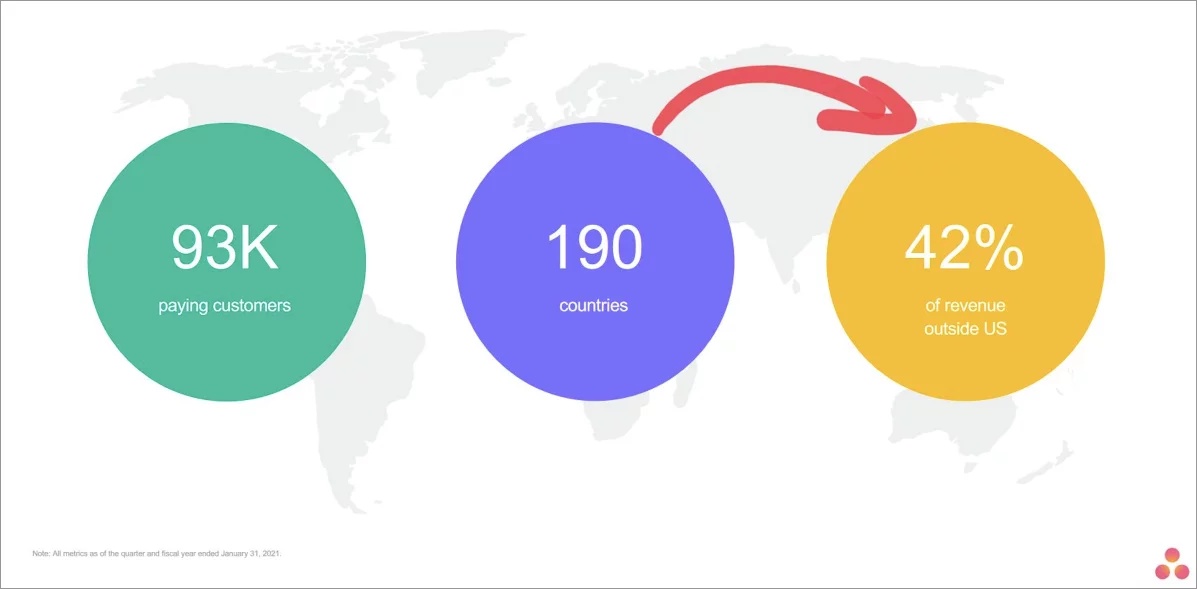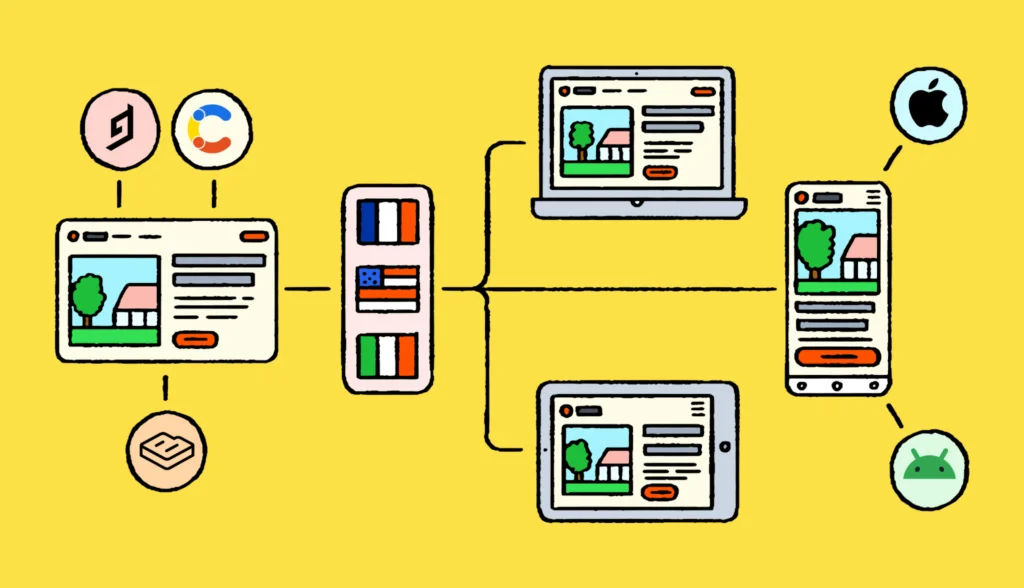We all know localization helps fuel international business expansion. Companies that invest in new languages grow. And companies that grow invest in new languages. Asana is a great example. Take a look at their earnings call, and you’ll see revenue growth is closely tied to international expansion strategies.
But building a great, global customer experience and continuously improving it requires company-wide commitment. You need a comprehensive plan that gets everyone on the same page, which is what localization strategy is all about.
What is a localization strategy?
A localization strategy is a plan for adapting products, services, content, messaging, marketing and brand to meet the needs of specific target markets. It includes things like language translation, cultural customization, and product design modifications to ensure relevance and appeal to local customers.
A successful localization strategy demands something from every department, because your customer’s experience always spans the entire journey: it begins the moment they discover your company and continues across all subsequent interactions.
Why is a localization strategy important for your business?
To deliver a “good” localized customer experience, localization must be involved at the tactical level within projects and business initiatives. To deliver a remarkable customer experience, localization needs to be represented in higher-level strategic discussions.
Take Asana’s earning call for example: C-level executives speaking about international growth and tying that to the new languages in which they plan to make the product available.
Even if your company is a much smaller organization, localization needs to have a seat at the table for it to be approached strategically. So, how do we do that?
5 localization strategy tips to keep in mind
If you’re ready to build your strategy and you want to do it right, the following approaches will help you tie localization into strategic initiatives and create stronger, global customer relationships.
1. Starting with a localized marketing strategy
Localization marketing is a strategy and a deliberate decision to invest resources in scaling your marketing efforts through localization.
You might do this in addition to other things, such as creating native content or locally driven campaigns. Or you might lean on localization as your primary method of marketing in other languages.
While “localized marketing” is generally used to refer to any process by which messages are created to resonate in other markets, marketing localization extends beyond messaging—it’s about adapting an entire experience.
Here’s a breakdown of the processes that fall under “localized marketing”:
| Process | Purpose | What gets adapted |
| Marketing translation | To have a process wherein a marketing message is created to resonate in other markets | Message (copy, text) |
| Marketing localization | To have a process wherein an experience is created to resonate in other markets | Message, visuals, UX elements |
| Localization marketing | To set out a digital marketing strategy that leverages localization in order to achieve growth | Systems and processes (in support of the strategy) |
The key is to consider your long-term international expansion strategy, company stage, and scale before you invest in localized marketing.
Here are some useful questions to think about in light of the above:
- What stage is your company at?
- Are you translating pieces of copy here and there, specific marketing messages, or entire campaigns?
- Do you intend to use localization as a strategy within your global growth toolkit?
For most companies, it’s best to start small and test new markets with localized messaging. Work on the microcopy first – slogans, key messages, and CTAs to get started. Do a pilot project to gain some initial traction, and then consider localizing entire experiences based on the data.
Expert corner: “It was clear that when some startups and scaleups began localizing their product, they saw a big uplift in business in other markets. But when you are a very small startup, you have to choose your battles.” Edward Cooper, Head of Mobile at Revolut.
2. Inclusivity: humanize your localization and translation
Inclusion is all about ensuring that customers are not being excluded from a delightful product experience due to language issues. That means considering the human element at the heart of how we work, communicate, and connect.
To develop trust as you enter a new market means shifting your thinking away from the company and towards the customer. To better understand how to create and optimize for inclusivity, we spoke with Bill Lafferty, Solutions Architect at Acclaro — one of our LSP partners. Here’s what we learned.
A few grammatical errors are one thing, but ignoring localization means you run the risk of not only offending your potential customers (never a good idea!) but also losing their trust. They’ll be able to tell if you care about them or not by the way you design and translate your software or website.
This means taking into account more than the words — the cultural norms, nuances, and expectations, too. “Consider something as small as honorifics, which are titles or words expressing politeness or respect. How you greet your customers matters, especially if they’re “meeting” you for the first time through your website,” Lafferty shared.
In Japan, for example, it’s expected that you always add the gender-neutral suffix “sama” when interacting with customers. But it can come up in more subtle ways, such as on a form customers fill out to get in touch with you — do you have space for multiple middle names in Latin American countries?
3. Anticipate localization needs during design and development
In an ideal world, you should be thinking about localization from the design stage. Design-stage localization is a powerful way to continuously release fully localized products like mobile apps, web apps, and games.
When you design with localization in mind, designers can create their prototypes and mockups in Figma, Sketch, or Adobe XD, populate them with different languages, and are able to check how the design will look with different translations early in the process.
That means your designer can adapt the design to suit different locales before a single line of code is written. You’ll catch any potential bugs or design breaks before they happen, and most importantly, you can increase your time to market. In fact, a company called Withings increased localized feature rollout by 90% using Figma and Lokalise.
Bottom line: You already prototype user experiences in the primary language of your product, check to see if text fits within buttons, how layouts change on different devices, etc. Why not do this for your global audience?
4. Document your brand and build a localization kit
The easiest way to future-proof your localization strategy is to document everything about your brand and marketing strategy. If you don’t already have a style guide, create one. It should include information about:
- Your tone of voice and whether it’s friendly, formal, or something in between.
- Common industry or company terms, acronyms, and phrases and what they mean.
- Examples of competitors you like or dislike and why.
- Specific conventions and elements of grammar to avoid, such as contractions.
- The personality of your company and what it’d be like if it were a person.
Translators use this to make sure their work reflects your brand, and since multiple translators will likely work on a single project, you need to make sure everyone is on the same page.
Consider, however, what your brand will translate to in a foreign market. You want translators to easily see not just the words, but also how cultural differences can be accommodated without losing what makes your brand special.
The documentation is a good start in determining how your brand will flex and change to meet another market’s cultural preferences. You should also document your website structure and any best practices with mobile versus desktop coding and browsing.
Different markets engage with the internet differently, so be aware of how you want your brand identity to look and feel everywhere, and make sure that the foundation of your website can handle multiple sites in different languages.
5. Who owns the localization strategy? Everyone
Your entire team should be a part of your localization strategy — from software developers to business owners. Any plan you build should include training on aspects of your new markets, as well as how to use any localization tools you choose. Include:
- Designers, so they can design defensively and choose culturally relevant images.
- Developers, so they understand the code implications for multiple languages.
- Marketers, so they can craft campaigns that work across markets.
- Product managers, so they can stay on top of deadlines and markets.
- Business leaders, so they can see how localization fits into their tactical perspective.
“It will take your entire team to build a localization process that works for everyone,” Lafferty tells us.
How to build a localization strategy that works
Your localization strategy should also include the how. How will the localization process work in your organization? You’ll want to make sure you’re flexible, adaptable, and actively communicating among your team members, creating the expectation that localization is always a work in progress.
Your first decision should be about how you want to incorporate localization into your existing development process. At Lokalise, we recommend agile localization — a set of software development methodologies that are based on iterative and cross-functional team collaboration approaches.
Translations aren’t just done once and delivered at the end of the development cycle. Instead, they are translated as the product is being developed. This means that once new iterations are released, translators or localization teams can simultaneously work on the localization of the changes happening in the product.
As you’re working on newer markets, this process allows you to see the impact of what you’re doing right away, rather than delaying the release of a specific part of your product or website for localization.
There are various approaches to a localization workflow, but the four most common steps are:
- Uploading or importing the source to the translation management system (TMS).
- Translation.
- Review, which may be omitted in small-scale projects.
- Delivery of the translated content to end users.
Developers supply the source code, which they pass on to product managers or marketers who then submit the source for translation. Translators localize the material and pass it back to business stakeholders for review. Developers then incorporate the newly translated files into their source code, and the translations go live.
The process involves a lot of steps, but much of the communication and handoffs can be automated with the right TMS. Lokalise, for example, provides you with advanced localization automation tools like Webhooks, API, and integrations with GitLab and Bitbucket that allow you to seamlessly integrate localization into your continuous delivery workflow.
How to measure your localization strategy
Localization requires commitment. You need to be invested in the translation process, including re-working your design and development to align with what’s described above. Once your process gets going, you need to measure your return on investment.
Here are several key performance indicators (KPIs) regarding localization that you can measure:
- Incremental sales, especially in the locations covered by the new languages.
- International SEO keyword ranking.
- Market share — is it increasing as a result of the localization?
- Cost of translations.
- Pageviews — compare pageviews of the website before and after localization. (As a result of good localization, you’ll start seeing an increase in the number of visitors from the target market. Depending on the form of the content you localized, it can also be video views, the article reads, etc.).
- Conversion rates — see how many people who visited your site purchased the product or service prior to localization and then after it.
- Social media engagement — measure engagement and keep track of content shares, as well as mentions of your brand on social media in the targeted market.
- Customer support cases — when you localize your product for a specific location and publish knowledge base articles in that language, you’re very likely to notice a decrease in the number of support cases from those languages.
Measuring and tracking these KPIs is the best way to understand your localization ROI.
Examples of Great Localization Strategy
Case study: Coca-Cola’s localization strategy
Few brands obtain global status like Coca-Cola. The brand has operated in more than 200 counties for over 100 years — you can order a “Coke,” a “Coca,” or a “Cola” depending on where you are. Their localization strategy is two-fold. On a product level, each version of Coca-Cola is slightly different, due to bottling in-country and adjusting to local taste preferences.
Every country has a slightly different take on the formula, packaging, and messaging that works best in their country, using local experts and native speakers and workers to expand their business. On a packaging level, their slogans remain simple and personalized, with a focus on universal words like “Enjoy,” “Happiness,” and “Sharing.” These are universal concepts easily translated into other cultural norms, driving more market share than any other soft drink around the world.
Case study: Starbucks’ localization strategy
Another global brand with a successful localization strategy is Starbucks. Starbucks formulates every menu with local items to fit the taste preferences of each country. By partnering with local coffee companies, they change the formulas and packaging to make the most sense for the market, emphasizing local ingredients, and innovative designs. By doing so, they can better capture customer loyalty in brand new markets.
Consider the flagship Starbucks store in Milan — a place famed for its coffee. Starbucks updated a well-known building rather than place a new Starbucks-branded store in the middle of a historic district. By working with local culture, Starbucks was able to successfully enter the Italian market and build an experience for locals and tourists alike.
Similarly, for Starbucks’ Japanese store, they hired local designers to incorporate local elements into the store, including traditional craftsmanship and a facade that fits right in with the local tea houses and shops. Tea may be the preferred drink in Japan, but by adapting their operations to the local culture, Starbucks was able to easily enter the market.
Use Lokalise to implement your localization strategy
Now that you understand more about what goes into a localization strategy, it’s time to put it into action. Grab a free Lokalise trial to implement your localization strategy, so you can improve your customers’ experience of your website and accelerate international expansion.





